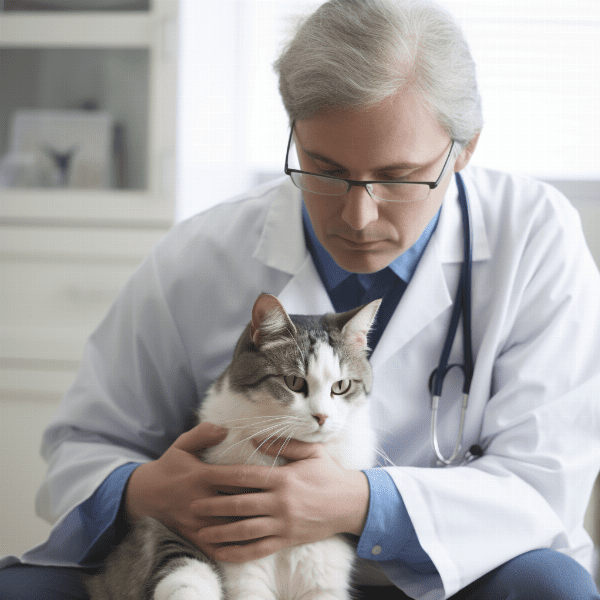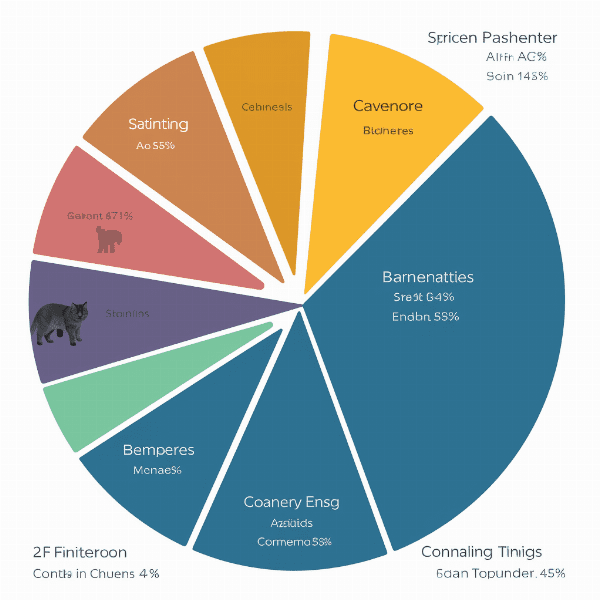Table of Contents
- Understanding Lung Cancer in Cats
- Causes and Risk Factors of Lung Cancer in Cats
- Common Symptoms of Lung Cancer in Cats
- Diagnosing Lung Cancer in Cats
- Treatment Options for Lung Cancer in Cats
- Surgery for Lung Cancer in Cats
- Chemotherapy and Radiation Therapy for Lung Cancer in Cats
- Palliative Care for Cats with Lung Cancer
- Preventing Lung Cancer in Cats
- Coping with a Diagnosis of Lung Cancer in Your Cat
Understanding Lung Cancer in Cats
Lung cancer in cats occurs when there is an uncontrolled growth of abnormal cells in the lungs. This type of cancer can be very aggressive and can spread quickly to other areas of the body. In this section, we will discuss the different types of lung cancer that can affect cats, as well as their causes and risk factors.
Types of Lung Cancer in Cats
There are two primary types of lung cancer in cats: primary and secondary. Primary lung cancer is when the cancer originates in the lung tissue itself, while secondary lung cancer occurs when cancer cells spread to the lungs from another part of the body.
Primary lung cancer can be further categorized into two subtypes: bronchogenic carcinoma and carcinoma in situ. Bronchogenic carcinoma is the most common type of primary lung cancer in cats, and it originates in the cells that line the airways in the lungs. Carcinoma in situ is a less common subtype that is confined to the surface layer of the lung tissue and has not spread deeper into the lung.
Causes and Risk Factors of Lung Cancer in Cats
The exact causes of lung cancer in cats are not fully understood, but there are several known risk factors. Exposure to secondhand smoke is a major risk factor for lung cancer in cats, as is exposure to environmental pollutants and toxins. Cats that are exposed to these risk factors over a long period of time are more likely to develop lung cancer.
Other risk factors for lung cancer in cats include age, genetics, and a weakened immune system. Cats that are over the age of 10 are more likely to develop lung cancer, and certain breeds of cats may be more genetically predisposed to the disease.
In the next section, we will discuss the common symptoms of lung cancer in cats, so you can be better prepared to recognize this disease in your feline companion.

Causes and Risk Factors of Lung Cancer in Cats
The causes of lung cancer in cats are not fully understood, but there are several known risk factors that can increase a cat’s likelihood of developing this disease. In this section, we will discuss these risk factors in more detail.
Environmental Risk Factors
Exposure to environmental pollutants and toxins is a major risk factor for lung cancer in cats. Secondhand smoke is a well-known environmental risk factor, as cats that live in homes with smokers have a higher risk of developing lung cancer. Other environmental risk factors include exposure to asbestos, diesel exhaust, and radon.
Age and Genetics
Cats that are over the age of 10 are more likely to develop lung cancer. Additionally, certain breeds of cats may be more genetically predisposed to the disease. Siamese cats, for example, are more likely to develop lung cancer than other breeds.
Weakened Immune System
A weakened immune system can also increase a cat’s risk of developing lung cancer. Cats that have Feline Immunodeficiency Virus (FIV) or Feline Leukemia Virus (FeLV) are more susceptible to developing cancer, including lung cancer. Additionally, cats that are undergoing chemotherapy or radiation therapy for another type of cancer may be more likely to develop lung cancer as a result of their weakened immune system.
It’s important to note that not all cats with risk factors will develop lung cancer, and some cats without any known risk factors may still develop the disease. In the next section, we will discuss the common symptoms of lung cancer in cats, so you can be better prepared to recognize this disease in your feline companion.
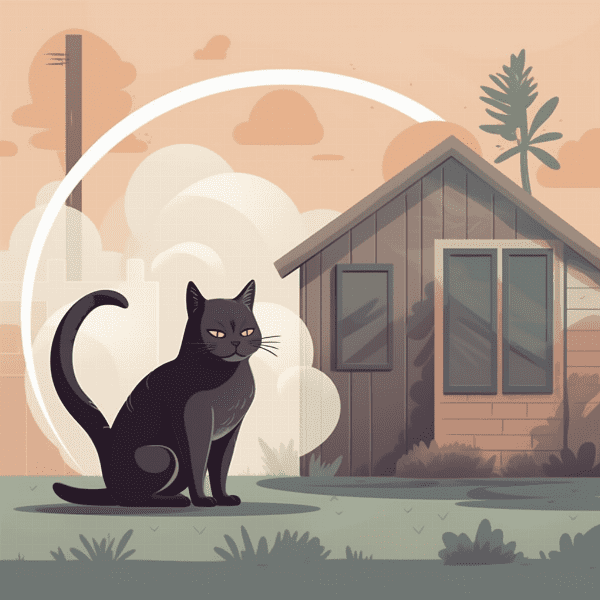
Common Symptoms of Lung Cancer in Cats
Lung cancer in cats can be difficult to detect in its early stages, as cats are known to hide their pain and discomfort. However, there are several common symptoms that may indicate the presence of lung cancer. In this section, we will discuss these symptoms in more detail.
Respiratory Symptoms
Respiratory symptoms are the most common symptoms of lung cancer in cats. These symptoms include coughing, wheezing, and difficulty breathing. Cats with lung cancer may also have an increased respiratory rate or panting, and may appear to be struggling to catch their breath.
Weight Loss and Loss of Appetite
Cats with lung cancer may experience weight loss and loss of appetite. This is because the cancer can cause a decrease in the cat’s metabolism, making it more difficult for them to maintain a healthy weight. Additionally, the cancer can cause a loss of appetite or difficulty swallowing, making it difficult for the cat to eat.
Lethargy and Weakness
Cats with lung cancer may also experience lethargy and weakness. This is because the cancer can cause a decrease in the cat’s energy levels, making it more difficult for them to move around or engage in their usual activities.
Behavioral Changes
Cats with lung cancer may exhibit behavioral changes, such as hiding or avoiding contact with their owners. This may be due to their discomfort or pain, or it may be a result of their decreased energy levels.
Other Symptoms
Other symptoms of lung cancer in cats may include vomiting, diarrhea, and a fever. These symptoms are less common than the respiratory symptoms, but they can still occur in some cats.
If you notice any of these symptoms in your cat, it’s important to take them to the veterinarian for an evaluation. In the next section, we will discuss how lung cancer in cats is diagnosed, so you can be better prepared to help your feline companion.

Diagnosing Lung Cancer in Cats
Diagnosing lung cancer in cats can be challenging, as the symptoms of this disease are often non-specific and can be caused by a variety of other conditions. In this section, we will discuss the different methods used to diagnose lung cancer in cats.
Physical Examination and History
The first step in diagnosing lung cancer in cats is to perform a physical examination and take a thorough medical history. The veterinarian will ask about the cat’s symptoms, medical history, and any environmental or genetic risk factors that may be present.
Radiography
Radiography, or X-rays, are often used to diagnose lung cancer in cats. This is because X-rays can detect the presence of tumors in the lungs, as well as any changes in the lung tissue. However, X-rays alone may not be enough to definitively diagnose lung cancer, as other conditions can also cause changes in the lung tissue.
Biopsy
A biopsy is the most definitive way to diagnose lung cancer in cats. This involves taking a small sample of lung tissue and examining it under a microscope for the presence of cancer cells. There are several different types of biopsies that can be used to diagnose lung cancer in cats, including fine-needle aspiration, bronchoscopy, and thoracoscopy.
Blood Tests
Blood tests can also be used to help diagnose lung cancer in cats. These tests can detect changes in the blood cells or chemistry that may be indicative of cancer. However, blood tests alone are not enough to definitively diagnose lung cancer, as these changes can also be caused by other conditions.
Other Diagnostic Tests
Other diagnostic tests that may be used to diagnose lung cancer in cats include computed tomography (CT) scans and magnetic resonance imaging (MRI) scans. These tests can provide a more detailed view of the lung tissue and can help identify the location and extent of any tumors.
If your cat is diagnosed with lung cancer, it’s important to discuss treatment options with your veterinarian. In the next section, we will discuss the different treatment options for lung cancer in cats.

Treatment Options for Lung Cancer in Cats
Once a cat has been diagnosed with lung cancer, there are several different treatment options available. The best treatment option will depend on several factors, including the type and extent of the cancer, as well as the cat’s overall health and age. In this section, we will discuss the different treatment options for lung cancer in cats.
Surgery
Surgery is often the primary treatment option for lung cancer in cats. This involves removing the tumor and any surrounding tissue that may be affected by the cancer. The success of surgery depends on the size and location of the tumor, as well as the cat’s overall health and age.
Alternative Therapies
There are several alternative therapies that may be used to help manage the symptoms of lung cancer in cats. These therapies include acupuncture, herbal remedies, and massage therapy. While these therapies may not be able to cure the cancer, they can help improve the cat’s overall well-being and quality of life.
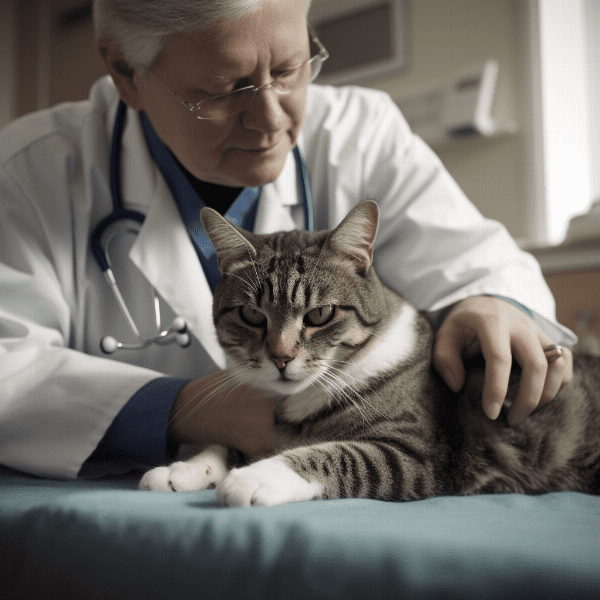
Surgery for Lung Cancer in Cats
Surgery is often the primary treatment option for cats with lung cancer, as it can be curative if the tumor is caught early enough. In this section, we will discuss the different types of surgery that may be used to treat lung cancer in cats.
Thoracoscopy
Thoracoscopy is a less invasive surgical procedure that involves making small incisions in the chest to gain access to the lungs. This procedure is used to remove tumors that are located near the surface of the lung tissue. Thoracoscopy is less invasive than a thoracotomy and may have a shorter recovery period.
Postoperative Care
After surgery for lung cancer, cats will require postoperative care to ensure that they recover properly. This may include pain management, nutritional support, and other supportive measures to help keep the cat comfortable. It’s important to follow your veterinarian’s instructions for postoperative care to ensure that your cat has the best chance of a successful recovery.
In some cases, cats may require additional treatment, such as chemotherapy or radiation therapy, to ensure that all of the cancer cells have been removed. It’s important to discuss the different treatment options with your veterinarian to determine the best course of treatment for your feline companion.
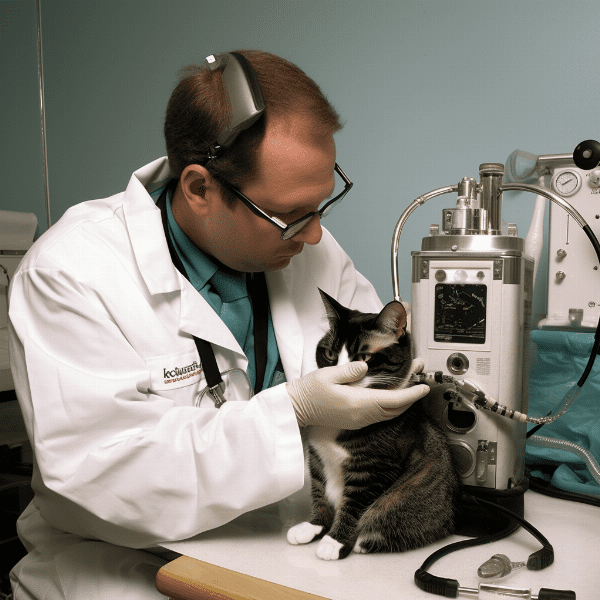
Chemotherapy and Radiation Therapy for Lung Cancer in Cats
Chemotherapy and radiation therapy are two treatment options that may be used to treat lung cancer in cats. In this section, we will discuss these treatment options in more detail.
Prognosis
The prognosis for cats with lung cancer depends on several factors, including the type and extent of the cancer, as well as the cat’s overall health and age. Chemotherapy and radiation therapy can be effective in controlling the growth and spread of cancer, but they may not be curative. Cats that undergo these treatments may have a better prognosis than cats that do not.
Side Effects
Both chemotherapy and radiation therapy can cause side effects in cats. Chemotherapy can cause nausea, vomiting, and a decrease in white blood cell count. Radiation therapy can cause skin irritation and fatigue. However, these side effects can be managed with medication and supportive care.
It’s important to discuss the different treatment options with your veterinarian, so you can make an informed decision about the best course of treatment for your feline companion. In the next section, we will discuss palliative care as a treatment option for cats with lung cancer.
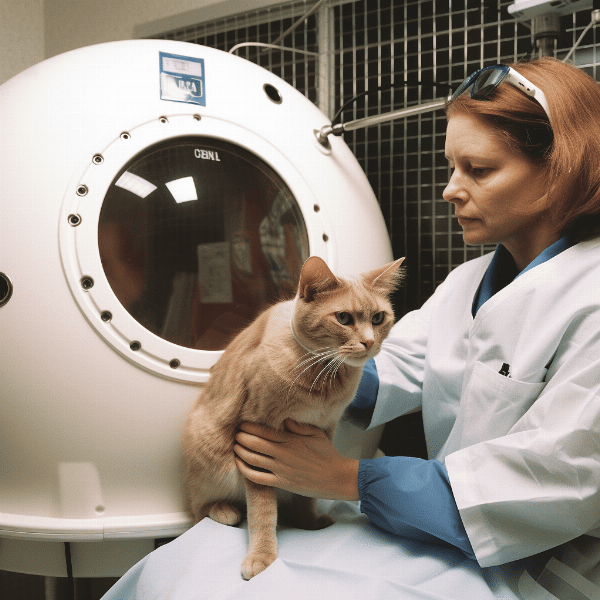
Palliative Care for Cats with Lung Cancer
Palliative care is a type of care that is focused on improving the quality of life for cats with lung cancer. This may include pain management, nutritional support, and other supportive measures to help keep the cat comfortable. In this section, we will discuss palliative care in more detail.
Pain Management
Pain management is an important aspect of palliative care for cats with lung cancer. Pain can be managed with medication, including non-steroidal anti-inflammatory drugs (NSAIDs), opioids, and other pain relievers. It’s important to work with your veterinarian to develop a pain management plan that is tailored to your cat’s individual needs.
Nutritional Support
Cats with lung cancer may experience a loss of appetite or difficulty swallowing, which can make it difficult for them to get the nutrients they need to maintain a healthy weight. Nutritional support, such as feeding your cat smaller, more frequent meals or providing high-calorie foods, can help ensure that your cat is getting the nutrients they need to stay healthy.
Supportive Care
Supportive care may include providing your cat with a comfortable and quiet environment, as well as providing them with plenty of love and attention. Cats with lung cancer may be more prone to infections, so it’s important to keep their living area clean and to monitor them for any signs of illness.
Prognosis
The prognosis for cats with lung cancer depends on several factors, including the type and extent of the cancer, as well as the cat’s overall health and age. Palliative care can help improve the quality of life for cats with lung cancer, but it may not be curative.
It’s important to work closely with your veterinarian to develop a palliative care plan that is tailored to your cat’s individual needs. This may include regular check-ups to monitor their condition and make any necessary adjustments to their treatment plan. With proper care and support, you can help ensure that your feline companion is as comfortable and happy as possible.

Preventing Lung Cancer in Cats
While it’s not always possible to prevent lung cancer in cats, there are several steps you can take to help reduce your cat’s risk of developing this disease. In this section, we will discuss some strategies for preventing lung cancer in cats.
Avoid Exposure to Secondhand Smoke
Secondhand smoke is a known risk factor for lung cancer in cats. If you smoke, it’s important to do so outside or in a well-ventilated area away from your cat. Additionally, you should encourage others in your household to do the same.
Provide a Healthy Diet and Regular Exercise
A healthy diet and regular exercise can help keep your cat’s immune system strong and may help reduce their risk of developing cancer. Be sure to provide your cat with a balanced diet that is rich in essential nutrients, and encourage regular exercise to help keep them healthy and active.
Limit Exposure to Environmental Toxins
Environmental toxins, such as pesticides and air pollution, can increase your cat’s risk of developing lung cancer. To limit your cat’s exposure to these toxins, consider using natural pest control methods, such as diatomaceous earth or neem oil, and keep your cat indoors when air quality is poor.
Regular Check-Ups with Your Veterinarian
Regular check-ups with your veterinarian can help detect any potential health issues early on, including lung cancer. Be sure to bring your cat in for regular check-ups and follow-up appointments as recommended by your veterinarian.
While it’s not always possible to prevent lung cancer in cats, taking these steps can help reduce your cat’s risk and keep them healthy and happy. By providing your feline companion with a healthy diet, regular exercise, and a smoke-free environment, you can help ensure that they live a long and healthy life.

Coping with a Diagnosis of Lung Cancer in Your Cat
Receiving a diagnosis of lung cancer in your cat can be overwhelming and stressful. In this section, we will discuss some strategies for coping with a diagnosis of lung cancer in your feline companion.
Seek Support
It’s important to seek support from family, friends, and other pet owners who have gone through a similar experience. Support can come in many forms, including emotional support, practical assistance, and advice. Consider joining a support group for pet owners or seeking the help of a professional counselor.
Educate Yourself
Learning more about lung cancer in cats can help you understand your cat’s diagnosis and treatment options. Talk to your veterinarian, do research online, and read books or articles on the topic.
Take Care of Yourself
Caring for a cat with lung cancer can be emotionally and physically exhausting. It’s important to take care of yourself by getting enough rest, eating a healthy diet, and engaging in activities that you enjoy.
Consider Palliative Care
Palliative care can help improve your cat’s quality of life and may be an option if curative treatment is not possible. Talk to your veterinarian about options for palliative care, such as pain management and nutritional support.
Make Memories
Spend quality time with your cat and create lasting memories. Take photos, go on walks, and engage in activities that your cat enjoys. These memories can help you cherish the time you have left with your feline companion.
Receiving a diagnosis of lung cancer in your cat can be difficult, but with the right support and care, you can help your cat live a comfortable and happy life. By educating yourself, seeking support, and taking care of yourself and your cat, you can make the most of the time you have together.
